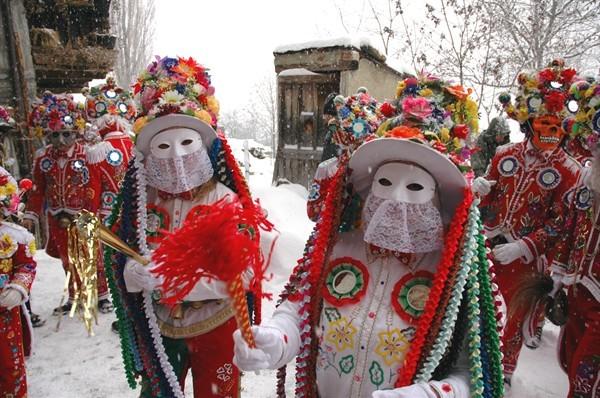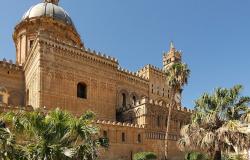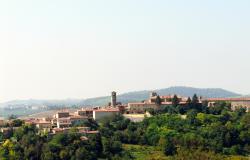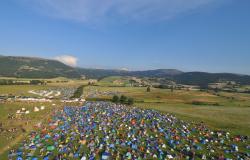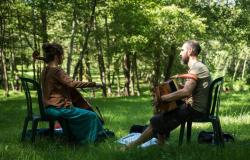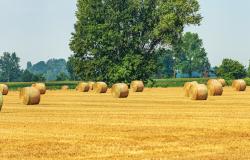For many villages in Valle d'Aosta, Carnival is a time when almost all the population works together and gets involved in the festive activities.
Probably less famous than Viareggio, Venice or Cento's carnival celebrations, the many special traditions linked to Carnevale in Valle d'Aosta offer an unforgettable variety of interesting and fun experiences in an Alpine context. The three most famous Carnival in Valle d'Aosta are the Carnevale di Verrès with its historical references and parade, the legendary Carnevale di Pont-Saint-Martin and, last but not least, the amazing Carnevale della Coumba Freida, in the villages around the Valle del Gran San Bernardo and the Valepelline valley, with spectacular costumes.
Verrès Carnival
The story of the Lady of the Castle, Caterina di Challant, - "friend of the people" - is reenacted every year by the people of Verrès, still grateful for her lovely gesture, which was most unusual for the time. The year was 1450 and Caterina di Challant and her husband came down to Verrès, escorted by a handful of armed guards. After lunch with the Reverendo Pietro di Chissé, Provost of the Minster of Saint Gilles, they made their way to the main square outside the church.
 Everyone started playing music and dancing and Caterina danced with the lively, young people of the town. The people's enthusiasm was at a peak and a unanimous cry went up: "Vive Introd et Madame de Challant". The echo of that joyful cry can still be heard today. Over 500 hundred years have gone by without erasing the memory of that day, and so every year, the whole population of Verrès eagerly awaits the celebration of Carnival time, with great enthusiasm. Playing the part of the aristocracy is a much sought-after role by all the townsfolk. There is a rich programme of events, with parades followed by a beautiful ball in the halls of the Castle that overlooks the town. Carnival reaches its climax every year when the main characters enter the town square. At the end, people listen intently to the town-crier's "Proclamation of the Citizenry" in a "strange but funny" ancient language.
Everyone started playing music and dancing and Caterina danced with the lively, young people of the town. The people's enthusiasm was at a peak and a unanimous cry went up: "Vive Introd et Madame de Challant". The echo of that joyful cry can still be heard today. Over 500 hundred years have gone by without erasing the memory of that day, and so every year, the whole population of Verrès eagerly awaits the celebration of Carnival time, with great enthusiasm. Playing the part of the aristocracy is a much sought-after role by all the townsfolk. There is a rich programme of events, with parades followed by a beautiful ball in the halls of the Castle that overlooks the town. Carnival reaches its climax every year when the main characters enter the town square. At the end, people listen intently to the town-crier's "Proclamation of the Citizenry" in a "strange but funny" ancient language.
Pont-Saint-Martin Carnival
Carnival celebrations in Pont-Saint-Martin are articulated around to different themes: the reenactment of the historical defeat of the Salassi by the Romans and the legend of the Nymph of the Lys.
The historical celebration recalling the defeat of the Salassi by the Romans, gives the losers the possibility of a "return match", in a "chariot race", which pits, once again, the local population against
the invaders.
According to the "Nymph" of the Lys legend, the mountain stream that crosses the town, she was upset with the locals and decided to swell the stream to destroy the town, but when the flood reached the Roman bridge, she was persuaded by the people's prayers, to slow down and pass through without causing damage. Playing the part of the Nymph is an honour which the young girls in town care about very much.
The Coumba Freida Carnivals
The cold blasts that blow down through the Valle del Gran San Bernardo and the Valepelline valley have earned this place the nickname of “Coumba Freida”, cold valley. Nevertheless, the freezing cold of this period is mitigated in February by the warmth and passion of the most unusual carnival in Valle d' Aosta.
 According to tradition, this carnival event was established in commemoration of the march through the Great St. Bernard Pass by Napoleon and his troops in May 1800, during his campaign in Italy.
According to tradition, this carnival event was established in commemoration of the march through the Great St. Bernard Pass by Napoleon and his troops in May 1800, during his campaign in Italy.
Therefore, the carnival costumes called "landzette" are traditionally an allegorical transformation of the uniforms originally worn by French Napoleonic soldiers. These expensive, and entirely hand-made, costumes are decorated with beads, sequins and small mirrors, which reflect the light and ward off evil spirits. The faces of the "landzette" are covered by masks that used to be made of wood; they carry the hair of a horse's tail in their hands and wear a belt with a bell around their waists. These elements are interpreted by anthropologists as symbolic instruments used to banish evil spirits.
During the parade, the carnival characters enter the homes of local families; they dance along the streets and in the squares and eat and drink whatever they are given. All the towns in the Valley have similar customs with some more or less significant differences. It is undoubtedly an unusual Carnival worth discovering, full of mystery, history and eccentricity.
